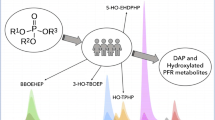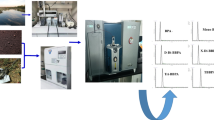Abstract
The aim of this paper was to develop an analytical method for determining the levels of the Benzo[a]pyrene (B[a]P) metabolites, 3-hydroxybenzo(a)pyrene (3-OHB[a]P), and (+)-anti-benzo(a)pyrene diol-epoxide( BPDE, combined with DNA to formate adducts) in the blood and brain tissue of B[a]P-exposed rats using high-performance liquid chromatography coupled with fluorescence detection (HPLC/FD). The chromatographic separation was performed with a CenturySIL BDS C18 column (150 mm × 4.6 mm, 5 μm) using mobile phases consisted of different methanol–water ratios [97:3 or 55:45 (v/v)] and different pHs (4.5 or 7.0). The amounts of 3-OHB[a]P and B[a]P-tetrols I-1 released after acid hydrolysis of (+)-anti-BPDE were detected by fluorescence at λ ex/λ em = 365/450 nm and λ ex/λ em = 245/395 nm. The calibration curves were linear (r 2 > 0.9990) for 3-OHB[a]P within 27–4320 ng mL−1 and for (+)-anti-BPDE within 1–160 ng mL−1, and the limits of detection (S/N = 3) of 3-OHB[a]P and (+)-anti-BPDE were 0.2 and 0.3 ng mL−1, respectively. Variation in intra- and inter-day assay as well as the data concerned with the stability of these compounds indicated no significant degradation under current experimental conditions. The average recoveries of the compound were in the range of 73.6 ± 5.0–113.5 ± 6.7 % for 3-OHB[a]P and 79.3 ± 6.2–141.2 ± 13.8 % for (+)-anti-BPDE. Our study have provided a sensitive, reliable, and rapid HPLC/FD-based method for the analysis of 3-OHB[a]P and (+)-anti-BPDE in rats blood and brain tissue.





Similar content being viewed by others
References
International Agency for Research on Cancer(IARC) (1987) Monographs on the evaluation of the carcinogenic risk of chemicals toman; 1972-present (multivolume work). World Health Organisation, Geneva p S758
Freeman DJ, Cattell FCR (1990) Wood burning as a source of atmospheric polycyclic aromatic hydrocarbons. Environ Sci Technol 24(10):1581–1585
Auchincloss AH, Diez Roux AV, Dvonch JT, Brown PL, Barr RG, Daviglus ML, Goff DC, Kaufman JD, O’Neill MS (2008) Associations between recent exposure to ambient fine particulate matter and blood pressure in the Multi-ethnic Study of Atherosclerosis (MESA). Environ Health Perspect 116(4):486–491
Liu LB, Hashi Y, Liu M, Wei Y, Lin JM (2007) Determination of particle-associated polycyclic aromatic hydrocarbons in urban air of Beijing by GC/MS. Analyt Sci 23(6):667–671
Pope CA, Burnett RT, Thurston GD, Thun MJ, Calle EE, Krewski D, Godleski JJ (2004) Cardiovascular mortality and long-term exposure to particulate air pollution: epidemiological evidence of general pathophysiological pathways of disease. Circulation 109(1):71–77
Miller K, Ramos K (2001) Impact of cellular metabolism on the biological effects of benzo[a]pyrene and related hydrocarbons. Drug Metab Rev 33(1):1–35
Jacobs DR Jr, Adachi H, Mulder I, Kromhout D, Menotti A, Nissinen A, Blackburn H (1999) Cigarette smoking and mortality risk: 25 year follow up of the seven countries study. Arch Intern Med 159(7):733–740
Jiang Y, Zhou X, Chen X, Yang G, Wang Q, Rao K, Xiong W, Yuan J (2011) Benzo(a)pyrene-induced mitochondrial dysfunction and cell death in p53-null Hep3B cells. Mutat Res 726(1):75–83
Sadikovic B, Andrews J, Carter D, Robinson J, Rodenhiser DI (2008) Genome-wide H3K9 histone acetylation profiles are altered in benzopyrene-treated MCF7 breast cancer cells. J Biol Chem 283(7):4051–4060
Won Hyokyoung, Yum Seungshic, Woo Seonock (2011) Identification of differentially expressed genes in liver of marine medaka fish exposed to benzo[a]pyrene. Toxicol Environ Health 3(1):39–45
International Agency for Research on Cancer (IARC) (1983) Polynuclear aromatic compounds, part 1, chemical, environmental and experimental data. Evaluation of carcinogenic risks to humans. IARC, Lyon, p 211
Compagnone D, Curini R, D’Ascenzo G, Del Carlo M, Montesano C, Napoletano S, Sergi M (2011) Neutral loss and precursor ion scan tandem mass spectrometry for study of activated benzopyrene-DNA adducts. Anal Bioanal Chem 401(6):1983–1991
Péry AR, Brochot C, Desmots S, Boize M, Sparfel L, Fardel O (2011) Predicting in vivo gene expression in macrophages after exposure to benzo(a)pyrene based on in vitro assays and toxicokinetic/toxicodynamic models. Toxicol Lett 201(1):8–14
Jacques C, Jamin EL, Perdu E, Duplan H, Mavon A, Zalko D, Debrauwer L (2010) Characterisation of B[a]P metabolites formed in an ex vivo pig skin model using three complementary analytical methods. Anal Bioanal Chem 396(5):1691–1701
Song Mi-Kyung, Yoon Ji-Seong, Song Mee, Choi Han-Seam, Shin Chan-Young, Kim Youn-Jung, Ryu Woo-In, Lee Hyo-Sun, Ryu Jae-Chun (2012) Gene expression analysis identifies DNA damage-related markers of benzo[a]pyrene exposure in HepG2 human hepatocytes. Toxicol Environ Health 4(1):19–29
Al-Saleh I, El-Doush I, Arif J, Coskun S, Jaroudi K, Al-Shahrani A, El-Din Mohamed G (2010) Levels of DNA adducts in the blood and follicular fluid of women undergoing in vitro fertilization treatment and its correlation with the pregnancy outcome. Bull Environ Contam Toxicol 84(1):23–28
Jacob J, Michaelson Saskia Trump, Rudzok Susanne, Gräbsch Carolin, Danielle J, Madureira Franziska Dautel, Mai Juliane, Attinger Sabine, Schirmer Kristin, von Bergen Martin, Lehmann Irina, Beyer Andreas (2011) Transcriptional signatures of regulatory and toxic responses to benzo(a)pyrene exposure. BMC Genom 12:502
Luch A (2005) The carcinogenic effects of polycyclic aromatic hydrocarbons. Imperial College Press, London
Weston A, Harris CC (2000) Chemical carcinogenesis. Holland-Frei Cancer Medicine, 5th edn. Hamilton, Ontario
Whitlock JP (1999) Induction of cytochrome P4501A1. Annu Rev Pharmacol Toxicol 39:103–125
Aktay G, Emre MH, Polat A (2011) Influence of dihydropyridine calcium antagonist nitrendipine on benzo(a)pyrene-induced oxidative stress. Arch Pharm 34(7):1171–1175
Boogaard PJ (2008) Urinary biomarkers in the risk assessment of PAHs. Occup Environ Med 65(4):221–222
Simon P, Lafontaine M, Delsaut P, Morele Y, Nicot T (2000) Trace determination of urinary 3-hydroxybenzo[a]pyrene by automated column-switching high-performance liquid chromatography. J Chomatogr B Biomed Sci Appl. 748(2):337–348
Payan Jean-Paul, Lafontaine Michel, Simon Patrice (2009) 3-Hydroxybenzo(a)pyrene as a biomarker of dermal exposure to benzo(a)pyrene. Arch Toxicol 83(2):873–883
Forster K, Preuss R, Rossbach B, Bruning T, Angerer J, Simon P (2008) 3-Hydroxybenzo[a]pyrene in the urine of workers with occupational exposure to polycyclic aromatic hydrocarbons in different industries. Occup Environ Med 65(4):224–229
Straif K, Baan R, Grosse Y, Secretan B, El Ghissassi F, Cogliano V (2005) Carcinogenicity of polycyclic aromatic hydrocarbons. Lancet Oncol 6(12):931–932
Marie C, Bouchard M, Heredia-Ortiz R, Viau C, Ma tre A (2010) A toxicokinetic study to elucidate 3-hydroxybenzo(a)pyrene atypical urinary excretion proWle following intravenous injection of benzo(a)pyrene in rats. J Appl Toxicol 30(5):402–410
Leroyer A, Jeandel F, Maitre A, Howsam M, Deplanque D, Mazzuca M, Nisse C (2010) 1-Hydroxypyrene and 3-hydroxybenzo[a]pyrene as biomarkers of exposure to PAH in various environmental exposure situations. Sci Total Environ 408(5):1166–1173
Xia H, Pan SS, Hu X, Srivastava SK, Pal A, Singh SV (1998) Cloning, expression, and biochemical characterization of a functionally novel alpha class glutathione s-transferase with exceptional activity in the glutathione conjugation of (+)-anti-7,8-dihydroxy-9,10-oxy-7,8,9,10-tetrahydrobenzo(a)pyrene. Arch Biochem Biophys 353(2):337–348
Gendre C, Lafontaine M, Delsaut P, Simon P( (2004) Exposure to polycyclic aromatic hydrocarbons and excretion of urinary 3-hydroxybenzo[a]pyrene: assessment of an appropriate sampling time. Polycyclic Aromat Compd 24:433–439
Boysen G, Hecht SS (2003) Analysis of DNA and protein adducts of benzo[a]pyrene in human tissues using structure-specific methods. Mutat Res 543(1):17–30
Byung Lee Mu, Santella R (1988) Quantitation of protein adducts as a marker of genotoxic exposure: immunologic detection of benzo(a)pyrene-globin adducts in mice. Carcinogenesis 9(10):1773–1777
Frank Stefanie, Renner Thomas, Ruppert Thomas, Scherer Gerhard (1998) Determination of albumin adducts of (+)-anti-benzo[a]pyrene-diol-epoxide using an high-performance liquid chromatographic column switching technique for sample preparation and gas chromatography-mass spectrometry for the final detection. J Chromatogr B Biomed Sci Appl 713(2):331–337
Pastorelli Roberta, Restano Jolanda, Guanci Marco, Maramonte Monica, Magagnotti Cinzia, Allevi Riccardo, Lauri Davide, Fanelli Roberto, Airoldi Luisa (1996) Hemoglobin adducts of benzo[a]pyrene diolepoxide in newspaper vendors: association with traffic exhaust. Carcinogenesis 17(11):2389–2394
Padrós J, Pelletier P (2001) Subpicogram determination of (+)-anti-benzo[a]pyrene diol-epoxide adducts in fish albumin and globin by high-performance liquid chromatography with fluorescence detection. Analytica Chimica Acta 426:71–77
Barry Smith W, Robert Hurtubise J (2004) New methodology for the characterization of.(±)-anti-BPDE-DNA adducts and tetrol I-1 with solid-matrix phosphorescence. Analytica Chimica Acta 502:149–159
Won L, Hye SS, Jee EH, Heesoo P, Yunje K (2003) Studies on the analysis of Benzo(a)pyrene and its metabolites in biological samples by using high performance liquid chromatograpy/fluorescence detection and gas chromatography/mass spectrometry. Bull Korean Chem Soc 24(5):559–565
Alexandrov K, Rojas M, Geneste O, Castegnaro M, Camus AM, Petruzzelli S, Giuntini C, Bartsch H (1992) An improved fluorimetric assay for dosimetry of benzo[a]pyrene diolepoxide-DNA adducts in smokers’s lung: comparisons with total bulky adducts and aryl hydrocarbon hydroxylase activity. Cancer Res 52(22):6248–6253
Rojas M, Alexandrov K, Schooten FJ, Hillebrand MJX, Kriek E, Bartsch H (1994) Validation of a new fluorimetric assay for benzo[a]pyrene diolepoxide-DNA adducts in human white blood cells: comparisons with 32P-postlabelling and ELISA. Carcinogenesis 15(3):557–560
Acknowledgments
This work is financially supported by the National Natural Science Foundation of China (30770724), the National Quality Inspection Science Foundation of China (L2013344), and Liaoning Provincial Department of Education Research Foundation of China (2013IK228).
Author information
Authors and Affiliations
Corresponding author
Additional information
X.-C. Liu, L. Qi, N. Ma contributed equally to this work.
Rights and permissions
About this article
Cite this article
Liu, XC., Qi, L., Ma, N. et al. Determination of 3-OHB[a]P and (+)-anti-BPDE in Rats Blood and Brain Tissue of B[a]P Exposure by HPLC with Fluorescence Detection. Chromatographia 78, 663–673 (2015). https://doi.org/10.1007/s10337-015-2890-2
Received:
Revised:
Accepted:
Published:
Issue Date:
DOI: https://doi.org/10.1007/s10337-015-2890-2




